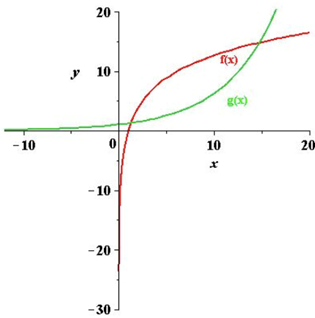
Concept explainers
a.
To approximate the intersection points of two graphs.
a.
Answer to Problem 98E
The points of intersection are  and
and 
Explanation of Solution
Given Information:
The given functions are  and
and  where
where 
Calculation:
It has been given that  and the graph corresponding to the functions is given below:
and the graph corresponding to the functions is given below:

From the above figure, it appears that the graphs intersect at two points. Using the intersect feature or zoom and trace feature, it is determined that the graphs intersect twice at approximately  and
and 
b.
To find out the value of  for which the two graphs have one point of intersection.
for which the two graphs have one point of intersection.
b.
Answer to Problem 98E

Explanation of Solution
If 

Intersect exactly once, then

The graphs of  and
and  intersect once for
intersect once for 
Then


Now,

For  the curves intersect once at
the curves intersect once at 
c.
To find out value of  for which the two graphs have two points of intersection.
for which the two graphs have two points of intersection.
c.
Answer to Problem 98E

Explanation of Solution
For the curves intersect twice.
the curves intersect twice.
For,  the curves do not intersect.
the curves do not intersect.
Chapter 3 Solutions
EBK PRECALCULUS W/LIMITS
- Explain the key points and reasons for the establishment of 12.3.2(integral Test)arrow_forwardUse 12.4.2 to determine whether the infinite series on the right side of equation 12.6.5, 12.6.6 and 12.6.7 converges for every real number x.arrow_forwarduse Cauchy Mean-Value Theorem to derive Corollary 12.6.2, and then derive 12.6.3arrow_forward
- Explain the focus and reasons for establishment of 12.5.1(lim(n->infinite) and sigma of k=0 to n)arrow_forwardExplain the focus and reasons for establishment of 12.5.3 about alternating series. and explain the reason why (sigma k=1 to infinite)(-1)k+1/k = 1/1 - 1/2 + 1/3 - 1/4 + .... converges.arrow_forwardExplain the key points and reasons for the establishment of 12.3.2(integral Test)arrow_forward
 Calculus: Early TranscendentalsCalculusISBN:9781285741550Author:James StewartPublisher:Cengage Learning
Calculus: Early TranscendentalsCalculusISBN:9781285741550Author:James StewartPublisher:Cengage Learning Thomas' Calculus (14th Edition)CalculusISBN:9780134438986Author:Joel R. Hass, Christopher E. Heil, Maurice D. WeirPublisher:PEARSON
Thomas' Calculus (14th Edition)CalculusISBN:9780134438986Author:Joel R. Hass, Christopher E. Heil, Maurice D. WeirPublisher:PEARSON Calculus: Early Transcendentals (3rd Edition)CalculusISBN:9780134763644Author:William L. Briggs, Lyle Cochran, Bernard Gillett, Eric SchulzPublisher:PEARSON
Calculus: Early Transcendentals (3rd Edition)CalculusISBN:9780134763644Author:William L. Briggs, Lyle Cochran, Bernard Gillett, Eric SchulzPublisher:PEARSON Calculus: Early TranscendentalsCalculusISBN:9781319050740Author:Jon Rogawski, Colin Adams, Robert FranzosaPublisher:W. H. Freeman
Calculus: Early TranscendentalsCalculusISBN:9781319050740Author:Jon Rogawski, Colin Adams, Robert FranzosaPublisher:W. H. Freeman
 Calculus: Early Transcendental FunctionsCalculusISBN:9781337552516Author:Ron Larson, Bruce H. EdwardsPublisher:Cengage Learning
Calculus: Early Transcendental FunctionsCalculusISBN:9781337552516Author:Ron Larson, Bruce H. EdwardsPublisher:Cengage Learning





